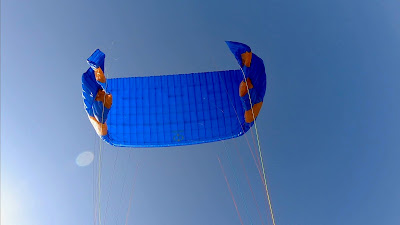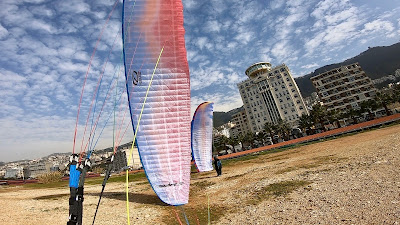PHI Maestro ( The wish maker )
PHI is a new brand founded by Mr. Hannes Papesh. The team behind PHI is one of the most experienced pilots like Mike Kung for instance, who’s in charge of testing and fine-tuning the gliders. Hannes Papesh is a legend when it comes to designing gliders. His favorite class is the B class. I still remember the beautiful Mentor 2 S size at the time, as it was delivering a spice feel with a very competitive performance that was close to some C or even D gliders at the time! It was a special dynamic glider with a competitive spirit. Will Hannes be able to manage the new Maestro? Let's see…
The Maestro 21 75-95 arrived. It has 2 lines per side on the A’s, 3 on the B’s 2 on the C’s. Very minimalistic, thin line configuration. There are lots of cells, and looking at it reminds me of the Phantom. All that package scream for performance.
The finish details and construction are excellent!
In my past testing, I learned that gliders that have fewer lines and especially 2 lines per side are likely to be flown slightly on the far end of their weight range in order to put a load on all the structure and keep it well homogenous in rough air. I found out that the sweet spot in overall conditions of the Maestro 21 is around 92, 93 all up. In moderate conditions, flying it at 90 or slightly below could be quite efficient also.
At 93 all up with an X-rated 6 harness, the launching of the Maestro 21 is super easy and well behaved, without any forward surge or hanging back.
After being airborne I immediately felt and understood the DNA inside this Maestro!
Let’s begin with the brake pressure that feels ‘perfect’. Not hard at all, nor too light! For my personal feel, it's just ‘perfect’ The response on the brakes are immediate! I could steer the Maestro inside the core with 10 cm of travel in a linear brake response, especially for a B !! The Maestro with its short brake travel reacts immediately and carve inside the thermals in a tight radius, with a high degree of precision, that is rare to find on a high B glider! Pure pleasure for the pros !! Going lower on the brakes is forgiving, but it’s not needed while coring, as around 15 cm max will let you core the meanest of thermals!
The day was special. It was windy and a bit turbulent at times. I was also surrounded by my expert flying friends, each one on their respective gliders. XC-Tracer small(2liner) , Klimber S, and a Swift 5 MS. All pilots are very well experienced. We did manage all-together, to make some small XC’s and to compare our little toys. ..Yes…I mentioned a 2 liner, and a D glider also…Just keep cool… No sudden conclusions ;-) I’m just spicing the write up a bit ;-) …
I also flew with a friend on the excellent Swift 5 MS, *my reference* for the B cat, (same size) and exactly same load! (93) as the Maestro 21.
After 4 hours of extensive flying, with the whole group, I can flawlessly confirm the excellent climbing abilities of the Maestro 21! This glider behaves and delivers exactly like a competition glider with D certificate in its climbing properties in strong air as it converts thermals into an efficient lift.
In very weak conditions, the swift 5 has the edge in float ability.
The Maestro surges forward in a good climb, without any pitch back at all. I mean it moves forward very quickly in climbing mode and coring the well built thermal. In windy and challenging conditions or facing the valley breeze, the Maestro will deliver good climbing when encountering strong thermals! Those characteristics are rare to be found on a B glider!
 Letting it fly forward is super rewarding while climbing. I can confirm that it climbs very close “to say the least and keep you cool… :-) “ as the higher certified gliders in strong thermals.
Letting it fly forward is super rewarding while climbing. I can confirm that it climbs very close “to say the least and keep you cool… :-) “ as the higher certified gliders in strong thermals.
I will comment later on accessibility, but I have to mention that keeping it flying is very rewarding, but swift and fine controls on the brakes are needed to keep it leveled. Just like flying some high rated gliders. A delight!
Now comes the gliding part.
I have to be clear that the top three B’s for 2019, have a very close gliding power as the C’s. For example, gliding with the Swift 5 against an Artik 5 showed me that the only difference is finding the next thermal !!
Even in difficult conditions, flying either glider, a pilot can only make a difference, with the extra 2 km on the top end of a C and the feel of a higher aspect ratio glider which also helps in marginal conditions.
Doing some long glides with the Maestro 21 at trim and at full bar showed me a super competitive glide angle similar to the best reference B, putting the Maestro on the top regarding gliding power.
It’s gliding in moving air and difficult conditions that the Maestro could be quite rewarding.
Now comes the accessibility part.
The Maestro is definitely ‘not’ your first B glider. Not even after one small season on your first low B glider… The Maestro has some super fine qualities and delivers impressive and valuable information for the keen pilot. It takes an experienced pilot to appreciate it and to use it at its full potential.
Talking for the B category, the Maestro is like a Samurai sword if you know what I mean. It can cut swiftly and cleanly if you seek it or know how to use it.
Pilots flying some C’s and even D’s wanting a great weapon for XC with B certification will cherish the Maestro feel and qualities.
Pilots flying high B gliders for a season will find in the B certified Maestro, the educative feedback that will allow them to understand and fly later higher rated gliders.
I also flew the Maestro at 89 all up. In weak conditions, the Swift 5 still have an edge. In strong air, the Maestro climbs well even at that load as I said earlier, but I felt that at 93…94 could be quite rewarding in strong and heavy turbulence. Loading it up is a good option in alpine conditions.
Big ears are stable, very efficient as only 1 line is left on the A’s, and they open without pilot intervention.
Wing overs are quickly very high. The Maestro has good energy, and the structure if well loaded is compact and homogenous.
Full speed is around 14 km/h over trim taken at 1000 ASL. Trim speed is slightly faster than to the Rush 5, Swift 5. Top speed is around 2 km/h more than the Swift 5 similarly loaded.
Conclusion: The best impressions you get is immediately after landing. Right?
This is one of the fewest times, I enjoy test-flying a B glider. It’s not like driving an 8 cylinder family car. It’s like driving an “every day” Sportscar! Comfortable enough but pleasurable to drive.
Today’s top high B gliders deliver impressive performance, and it’s a blessing for many pilots to get those performances for free…But some commented getting bored when flying B gliders, probably because of their very comfortable and dampening behavior on all axes and sometimes lesser brake authority. It’s not the case with the Maestro that responds swiftly and precisely to every input.
Pilots who feel too much dampening under a certain glider or seek more sporty feel will eventually seek the higher classes.
Every pilot has a different level of experience and totally different taste regarding gliders.
The Maestro has a complete package of top overall performance, the agile feel of a dynamic but “balanced” high B glider.
Flying pleasure awaits you with spices for the refined gastronomist! :-)
For those flying qualities, test flying it is a must.
UPDATE for the Maestro 19
I flew the size 19 ( 70-85) at 84 all up. The size 19 feels very different for the bigger size in the test. It does have a pitch back before entry. It's very agile and nice to fly. The glide is also at the top NB category. It does require a good high B pilot level.



























